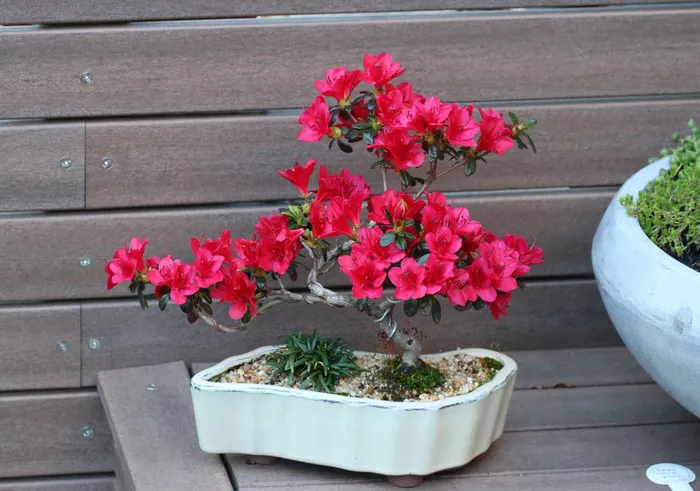Azalea bonsai, with their delicate blooms and graceful forms, captivate enthusiasts around the world. These miniature marvels offer a unique blend of natural beauty and artistic expression, making them a prized addition to any bonsai collection. In this guide, we’ll delve into the intricacies of azalea bonsai care, covering everything from essential maintenance to troubleshooting common problems.
Azalea Bonsai Overview
1. What is Azalea Bonsai?
Azalea bonsai, derived from various species of Rhododendron, are renowned for their vibrant flowers, fine foliage, and elegant structure. These miniature trees evoke a sense of tranquility and harmony, reflecting the beauty of nature in a compact form. The appeal of azalea bonsai lies not only in their aesthetic charm but also in the challenge of nurturing them to thrive in a confined space.
2. Types of Azalea Bonsai
Several azalea varieties are popular choices for bonsai cultivation, each offering unique characteristics and aesthetic qualities. Among the most favored are the Satsuki and Kurume azaleas. Satsuki azaleas are prized for their prolific flowering and diverse flower forms, ranging from single to double blooms in various colors. Kurume azaleas, originating from Japan, feature small leaves and delicate flowers, making them well-suited for bonsai cultivation.
3. Special Care Considerations
Azalea bonsai have specific care requirements that distinguish them from other bonsai species or regular azaleas. They thrive in slightly acidic soil with good drainage, necessitating regular monitoring of moisture levels. Additionally, azaleas are sensitive to environmental conditions, requiring adequate humidity and protection from extreme temperatures. Understanding these unique needs is essential for ensuring the health and vitality of your azalea bonsai.
Essential Care Guidelines
1. Placement and Sunlight
Azalea bonsai flourish in bright, indirect light. Place them in a location where they receive morning sun and dappled shade in the afternoon to prevent scorching of leaves. Avoid exposing them to direct sunlight for extended periods, as this can lead to leaf burn and stress.
2. Watering
Proper watering is crucial for the health of azalea bonsai. Water thoroughly when the soil surface feels slightly dry to the touch, ensuring that excess water drains freely from the pot. Avoid overwatering, as this can lead to root rot, while underwatering can cause stress and dehydration. Using a moisture meter or observing the soil moisture level can help determine the appropriate watering frequency.
3. Humidity
Azalea bonsai thrive in humid environments, mimicking their natural habitat in woodland areas. To increase humidity around the bonsai, place it on a humidity tray filled with water or use a room humidifier. Misting the foliage regularly can also help maintain adequate moisture levels, especially during dry periods or in heated indoor environments.
4. Temperature
Maintaining optimal temperature conditions is essential for the health and vigor of azalea bonsai. They prefer temperatures ranging from 60°F to 75°F (15°C to 24°C) during the growing season, with slightly cooler temperatures in winter to promote dormancy. Protect bonsai from frost and extreme heat, providing shelter or insulation as needed to prevent damage.
5. Soil and Fertilization
A well-draining soil mix is essential for azalea bonsai, allowing roots to breathe and preventing waterlogged conditions. Use a blend of organic matter, such as peat moss or pine bark, mixed with inorganic components like perlite or pumice. Fertilize azalea bonsai regularly during the growing season with a balanced fertilizer formulated for acid-loving plants. Avoid excessive nitrogen, as it can promote vegetative growth at the expense of flowering.
6. Pruning and Shaping
Pruning and shaping are fundamental aspects of azalea bonsai care, shaping the tree’s form and promoting ramification. Regularly remove dead or diseased branches, as well as any growth that detracts from the desired silhouette. Use sharp bonsai shears to make clean cuts, and wire branches to guide their growth and create elegant shapes. Pruning should be performed after flowering to avoid removing potential buds.
7. Repotting
Repotting is necessary to refresh the soil, prevent root-bound growth, and promote healthy development. Repot azalea bonsai every two to three years in early spring before new growth emerges. Trim back long roots and remove any circling roots to encourage a compact root system. Choose a slightly larger pot with good drainage, using fresh soil to support the bonsai’s continued growth.
Troubleshooting and Common Problems:
1. Pest and Disease Identification
Azalea bonsai are susceptible to pests such as aphids, spider mites, and scale insects, as well as fungal diseases like powdery mildew and root rot. Regularly inspect the foliage and soil for signs of infestation or disease, including yellowing leaves, sticky residue, or moldy growth. Treat affected plants promptly with appropriate pesticides or fungicides, following label instructions carefully to avoid harm to the bonsai.
2. Leaf Issues
Yellowing, browning, or dropping leaves can indicate various issues, including overwatering, underwatering, nutrient deficiencies, or pest infestations. Adjust watering practices, ensure proper drainage, and monitor soil pH and nutrient levels to address these problems. Remove affected leaves to promote new growth and maintain the bonsai’s overall health.
3. Flowering Problems
Failure to bloom or poor flowering can result from inadequate light, improper pruning, nutrient deficiencies, or environmental stress. Ensure azalea bonsai receive sufficient light and maintain a balanced fertilization regimen to support flower production. Avoid heavy pruning immediately before or during the flowering period, as this can remove flower buds and inhibit blooming. With proper care and attention, azalea bonsai can reward enthusiasts with a profusion of exquisite blooms year after year.
Conclusion
In conclusion, caring for an azalea bonsai requires a combination of patience, skill, and understanding of its unique needs. By providing the ideal growing conditions, practicing proper maintenance techniques, and promptly addressing any issues that arise, you can enjoy the beauty and tranquility of these miniature masterpieces for years to come.


